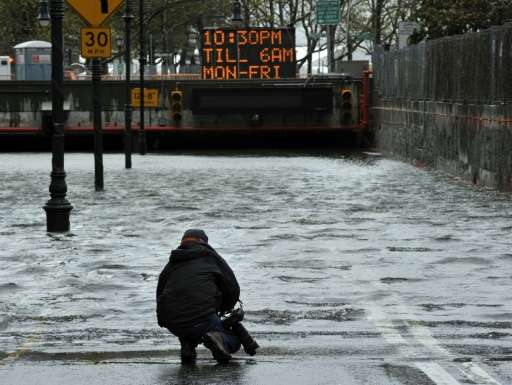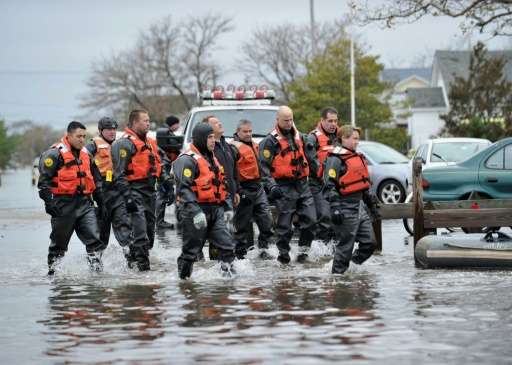New York braces for the looming threats of climate change

On calm days, waters innocently wash against the aging seawalls at Manhattan's southernmost park, but in decades to come they could inundate the island's lower districts.
If the latest apocalyptic climate change projections come true—with sea levels rising upwards of 28 inches (70 cm) by 2050—Wall Street and Ellis Island could be swallowed up.
The wrath of Superstorm Sandy—which killed more than 40 people—paralyzed New York in October 2012. The storm left the city shocked and sodden, ushering in new urgency among many over the looming threats of climate change in America's largest city.
"The conversation changed," said Daniel Zarrilli, who oversees the mayor's office of recovery and resiliency. "It's not something that's happening 100 years from now to someone far away.
"It is happening here and now."
A professional engineer, Zarrilli supervises the city's efforts to fortify its infrastructure and strengthen more than 500 miles (800 kilometers) of coastline against the threat of rising waters. The number of days hitting more than 90 degrees Fahrenheit (32 degrees Celsius) is predicted to triple.
"New York City is staying where it is," Zarrilli said, seeking to project assurance about an uncertain future. "It has developed over the last 400 years.
"We are here because we are the gateway to America."

Building for a warmer era
The engineer says the key to climate adaptation is assessing and reducing risk, and swiftly investing in those zones under the greatest threat.
Many hard-hit areas—as well as parts of the city's subway system—are still rebuilding from the destruction wrought by Sandy, reconstruction funded by a budget of more than $20 billion allocated by the city, state and federal governments.
At the same time the city has been erecting new developments in some of its most vulnerable areas: the new Hudson Yards district on Manhattan's northwest coast boasts skyscraper apartment buildings practically teetering on the banks of the Hudson River.
But Zarrilli says those buildings are actually among the city's most secure: "The safest place to be right now during any sort of threat is in a new building."
Steven Cohen, the executive director of Columbia University's Earth Institute, explained that future skyscrapers will install heating and electricity units on the second or third floors, rather than in basements, which had been standard protocol.
Cohen said scientists assume sea levels could rise anywhere from 4.5 to 15 feet in the future, but abandoning one of the world's most economically powerful cities is unreasonable.
"There is so much money and infrastructure in the city," he said. "The idea that you can walk away from it is just not cost-effective."

'Climate-ready' construction
The now abandoned Oakwood Beach neighborhood of the Staten Island borough saw entire rows of seaside bungalows bulldozed after Sandy's passing.
After New York Governor Andrew Cuomo offered local homeowners the chance to sell, the vast majority of residents did so, even if they had lived there for decades.
But in Manhattan such a buyout program would be "completely impossible," said Joe Tirone, a Staten Island real estate agent.
"It would not make sense in Manhattan, just because of the price of the properties," he said.
For many New Yorkers, the main short-term risk lies in skyrocketing insurance premiums. The areas covered by flood-zone maps will likely double, putting the number of residents living in high risk areas at 400,000.
The resulting insurance premium hike could prompt wealthier New Yorkers to flee swanky neighborhoods for higher ground, while threatening to push what's left of the city's dwindling lower classes out of their homes.
Zarrilli remains optimistic for the city's future flood resistance because of what he sees as the commitment from elected officials to support protective urban planning—even if the election of climate change skeptic Donald Trump creates an element of doubt.
"We will never be climate-safe," he said. "We will be climate-ready.
© 2016 AFP



















